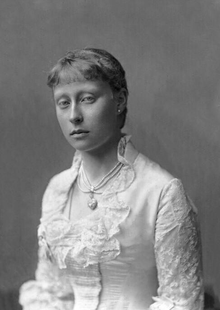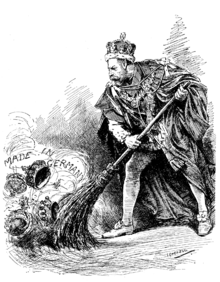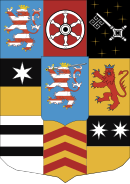Princess Victoria of Hesse and by Rhine
| Princess Victoria of Hesse and by Rhine | |
|---|---|
| Marchioness of Milford Haven | |
 Portrait by Alexander Bassano, c. 1878 | |
| Born | Princess Victoria Alberta Elisabeth Mathilde Marie of Hesse and by Rhine 5 April 1863 Windsor Castle, Windsor, Berkshire, England |
| Died | 24 September 1950 (aged 87) Kensington Palace, London, England |
| Burial | 28 September 1950 St Mildred's Church, Whippingham, Isle of Wight |
| Spouse |
Louis Mountbatten, 1st Marquess of Milford Haven (m. 1884; died 1921) |
| Issue |
|
Louis IV, Grand Duke of Hesse and by Rhine | |
| Mother | Princess Alice of the United Kingdom |
Princess Victoria of Hesse and by Rhine, then Princess Louis of Battenberg, later Victoria Mountbatten, Marchioness of Milford Haven (5 April 1863 – 24 September 1950), was the eldest daughter of
Born in
, and lived most of her married life in various parts of Europe at her husband's naval posts and visiting her many royal relations. She was perceived by her family as liberal in outlook, straightforward, practical and bright.During
Early life
Victoria was born on
Her early life was spent at
During the Prussian invasion of Hesse in June 1866, Victoria and Elisabeth were sent to Britain to live with their grandmother until hostilities were ended by the absorption of Hesse-Kassel and parts of Hesse-Darmstadt into Prussia.[4] During the Franco-Prussian War of 1870, military hospitals were set up in the palace grounds at Darmstadt, and she helped in the soup kitchens with her mother. She remembered the intense cold of the winter, and being burned on the arm by hot soup.[5]
In 1872, Victoria's eighteen-month-old brother, Friedrich, was diagnosed with haemophilia. The diagnosis came as a shock to the royal families of Europe; it had been twenty years since Queen Victoria had given birth to her haemophiliac son, Prince Leopold, Duke of Albany, and it was the first indication that the bleeding disorder in the royal family was hereditary.[6] The following year, Friedrich fell from a window onto stone steps and died. It was the first of many tragedies to beset the Hesse family.[7]

In early November 1878, Victoria contracted
Marriage and family
At family gatherings, Victoria had often met Prince Louis of Battenberg, who was her first cousin once removed and a member of a morganatic branch of the Hessian royal family. Prince Louis had adopted British nationality and was serving as an officer in the Royal Navy. In the winter of 1882, they met again at Darmstadt, and were engaged the following summer.[10]
After a brief postponement because of the death of her maternal uncle Prince Leopold, Duke of Albany,[11] Victoria married Prince Louis on 30 April 1884 at Darmstadt. Her father did not approve of the match; in his view Prince Louis—his own first cousin—had little money and would deprive him of his daughter's company, as the couple would naturally live abroad in Britain. However, Victoria was of an independent mind and took little notice of her father's displeasure.[12] Remarkably, that same evening, Victoria's father secretly married his mistress, Countess Alexandrine von Hutten-Czapska,[13] the former wife of Alexander von Kolemine, the Russian chargé d'affaires in Darmstadt. His marriage to a divorcee who was not of equal rank shocked the assembled royalty of Europe and through diplomatic and family pressure Victoria's father was forced to seek an annulment of his own marriage.[14]
Over the next sixteen years, Victoria and her husband had four children:
| Name | Birth | Death | Marriage |
|---|---|---|---|
| Alice | 25 February 1885 | 5 December 1969 | Married 1903 Prince Andrew of Greece and Denmark Five children, including the Duke of Edinburgh[15] |
| Louise | 13 July 1889 | 7 March 1965 | Married 1923 King Gustaf VI Adolf of Sweden (his second marriage)One stillborn daughter |
| George | 6 November 1892 | 8 April 1938 | Married 1916 Countess Nadejda Mikhailovna de Torby Two children[16] |
| Louis | 25 June 1900 | 27 August 1979 | Married 1922 Edwina Cynthia Annette Ashley Two children[17] |
They lived in a succession of houses at
She personally taught her own children and exposed them to new ideas and inventions.[21] She gave lessons to her younger son, Louis, until he was ten years of age. He said of her in 1968 that she was "a walking encyclopedia. All through her life she stored up knowledge on all sorts of subjects, and she had the great gift of being able to make it all interesting when she taught it to me. She was completely methodical; we had time-tables for each subject, and I had to do preparation, and so forth. She taught me to enjoy working hard, and to be thorough. She was outspoken and open-minded to a degree quite unusual in members of the Royal Family. And she was also entirely free from prejudice about politics or colour and things of that kind."[22]
In 1906, she flew in a
Later life

Prince Louis was forced to resign from the navy at the start of the war when his German origins became an embarrassment, and the couple retired for the war years to

Victoria's husband died in London in September 1921. After meeting her at the
In 1937, Victoria's brother, Ernest Louis, died and soon afterwards her widowed sister-in-law, nephew, granddaughter and two of her great-grandchildren all died in an
Further tragedy soon followed when Victoria's son, George, died of bone cancer the following year. Her granddaughter,
On 15 December 1948, the Dowager Marchioness attended the
She fell ill with bronchitis (she had smoked since the age of sixteen

Legacy
With the help of her
Lord Mountbatten remembered her fondly: "My mother was very quick on the uptake, very talkative, very aggressive and argumentative. With her marvellous brain she sharpened people's wits."[45] Her granddaughter thought her "formidable, but never intimidating ... a supremely honest woman, full of commonsense and modesty".[46] Victoria wrote her own typically forthright epitaph at the end of her life in letters to and conversation with her son: "What will live in history is the good work done by the individual & that has nothing to do with rank or title ... I never thought I would be known only as your mother. You're so well known now and no one knows about me, and I don't want them to."[47]
Honours
 Order of the Golden Lion, 1 January 1883[48]
Order of the Golden Lion, 1 January 1883[48] Kingdom of Prussia: Red Cross Medal, 1st Class[49]
Kingdom of Prussia: Red Cross Medal, 1st Class[49] Russian Empire: Dame Grand Cross of the Order of St. Catherine[49]
Russian Empire: Dame Grand Cross of the Order of St. Catherine[49] United Kingdom:[49]
United Kingdom:[49]
Ancestry
| Ancestors of Princess Victoria of Hesse and by Rhine | |||||||||||||||||||||||||||||||||||||||||||||||||||||||||||||||||||||||||||||||||||||||||||||||||||||
|---|---|---|---|---|---|---|---|---|---|---|---|---|---|---|---|---|---|---|---|---|---|---|---|---|---|---|---|---|---|---|---|---|---|---|---|---|---|---|---|---|---|---|---|---|---|---|---|---|---|---|---|---|---|---|---|---|---|---|---|---|---|---|---|---|---|---|---|---|---|---|---|---|---|---|---|---|---|---|---|---|---|---|---|---|---|---|---|---|---|---|---|---|---|---|---|---|---|---|---|---|---|
| |||||||||||||||||||||||||||||||||||||||||||||||||||||||||||||||||||||||||||||||||||||||||||||||||||||
References
| Grand Ducal Family of Hesse and by Rhine |
|---|
 |
| Louis IV |
- ISBN 0-297-78470-6.
- ^ Queen Victoria's Journals – Monday 27 April 1863
- ^ Hough, p. 30
- ^ Hough, p. 29
- ^ Hough, p. 34
- ^ Hough, p. 36
- ^ ISBN 978-0-19-861411-1. (Subscription or UK public library membershiprequired.)
- ^ Hough, pp. 46–48
- ^ Hough, p. 50
- ^ Hough, p. 57
- ^ Hough, p. 114
- ISBN 0-00-216543-0.
- ISBN 2-901138-01-2.)
{{cite book}}: CS1 maint: location missing publisher (link - ^ Hough, pp. 117–122
- ISBN 978-0-19-861411-1. (Subscription or UK public library membershiprequired.)
- ISBN 978-0-19-861411-1. (Subscription or UK public library membershiprequired.)
- ISBN 978-0-19-861411-1. (Subscription or UK public library membershiprequired.)
- ^ Hough, pp. 158–159
- ^ Hough, p. 169
- ^ Hough, pp. 213–214, 372 and 375
- ^ Hough, p. 177
- ISBN 0-09-922630-8.
- ^ Victoria Milford Haven quoted in Hough, p. 215
- ^ Hough, p. 264
- ^ Hough, p. 289
- ^ Hough, p. 274
- ISBN 0-241-13686-5.
- ^ Terraine, p. 10
- ISBN 978-0-938311-04-1.
- ^ Hough, p. 288
- ^ Kerr, Mark (1934). Prince Louis of Battenberg. London: Longmans, Green and Co. p. 261.
- ^ Hough, p. 333
- ^ Hough, p. 338
- ^ Vickers, pp. 200–205
- ^ Prince Philip quoted in Hough, p. 354
- OCLC 565356978.
- ^ Hough, p. 365
- ^ Hough, pp. 375 and 382
- ^ Ziegler, p. 359
- ^ "The Christening of Prince Charles". Royal Collection Trust. Retrieved 18 February 2022.
- ^ Hough, p. 53
- ^ Ziegler, p. 506
- ^ The memoir is available online.
- ISBN 0-434-34861-9.
- ^ Earl Mountbatten of Burma quoted in Hough, p. 339
- ^ Lady Pamela Hicks quoted in Hough, p. 373
- ^ Quoted in Hough, p. 387
- ^ "Goldener Löwen-orden", Großherzoglich Hessische Ordensliste (in German), Darmstadt: Staatsverlag, 1914, p. 1 – via hathitrust.org
- ^ a b c "Genealogie", Hof- und Staats-Handbuch des Großherzogs Hessen, 1904, p. 2
- ^ Joseph Whitaker (1897). An Almanack for the Year of Our Lord ... J. Whitaker. p. 110.
- ^ ISBN 0-7126-7448-9.
Further reading
- ISBN 978-0-345-40640-8.
- Miller, Ilana D. (2011). The Four Graces: Queen Victoria's Hessian Granddaughters. East Richmond Heights, California: Kensington House Books. ISBN 978-0-9771961-9-7. A "sisters" biography of the four surviving daughters of Princess Alice, Grand Duchess of Hesse and by Rhine, told from the point of view of Princess Victoria.
- Mountbatten, Victoria. Recollections of Victoria Mountbatten, Marchioness of Milford Haven (PDF).
External links
- St. Mildred's Church, Whippingham, Isle of Wight
- The Mountbatten Archive at the University of Southampton
- Portraits of Victoria, Marchioness of Milford Haven at the National Portrait Gallery, London
